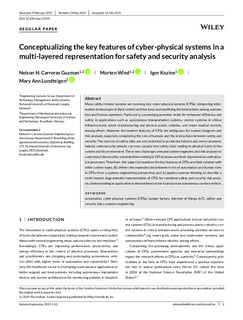| dc.contributor.author | Carreras Guzman, Nelson Humberto | |
| dc.contributor.author | Wied, Morten | |
| dc.contributor.author | Kozine, Igor | |
| dc.contributor.author | Lundteigen, Mary Ann | |
| dc.date.accessioned | 2019-11-21T11:23:02Z | |
| dc.date.available | 2019-11-21T11:23:02Z | |
| dc.date.created | 2019-10-14T15:09:14Z | |
| dc.date.issued | 2019 | |
| dc.identifier.citation | Systems Engineering. 2019, 1-22. | nb_NO |
| dc.identifier.issn | 1098-1241 | |
| dc.identifier.uri | http://hdl.handle.net/11250/2629734 | |
| dc.description.abstract | Many safety‐related systems are evolving into cyber‐physical systems (CPSs), integrating information technologies in their control architectures and modifying the interactions among automation and human operators. Particularly, a promising potential exists for enhanced efficiency and safety in applications such as autonomous transportation systems, control systems in critical infrastructures, smart manufacturing and process plants, robotics, and smart medical devices, among others. However, the modern features of CPSs are ambiguous for system designers and risk analysts, especially considering the role of humans and the interactions between safety and security. The sources of safety risks are not restricted to accidental failures and errors anymore. Indeed, cybersecurity attacks can now cascade into safety risks leading to physical harm to the system and its environment. These new challenges demand system engineers and risk analysts to understand the security vulnerabilities existing in CPS features and their dependencies with physical processes. Therefore, this paper (a) examines the key features of CPSs and their relation with other system types; (b) defines the dependencies between levels of automation and human roles in CPSs from a systems engineering perspective; and (c) applies systems thinking to describe a multi‐layered diagrammatic representation of CPSs for combined safety and security risk analysis, demonstrating an application in the maritime sector to analyze an autonomous surface vehicle. | nb_NO |
| dc.language.iso | eng | nb_NO |
| dc.publisher | Wiley | nb_NO |
| dc.relation.uri | https://onlinelibrary.wiley.com/doi/epdf/10.1002/sys.21509 | |
| dc.rights | Navngivelse 4.0 Internasjonal | * |
| dc.rights.uri | http://creativecommons.org/licenses/by/4.0/deed.no | * |
| dc.title | Conceptualizing the key features of cyber-physical systems in a multi-layered representation for safety and security analysis | nb_NO |
| dc.type | Journal article | nb_NO |
| dc.type | Peer reviewed | nb_NO |
| dc.description.version | publishedVersion | nb_NO |
| dc.source.pagenumber | 1-22 | nb_NO |
| dc.source.journal | Systems Engineering | nb_NO |
| dc.identifier.doi | 10.1002/sys.21509 | |
| dc.identifier.cristin | 1736936 | |
| dc.description.localcode | © 2019 The Authors. Systems Engineering published by Wiley Periodicals, Inc. This is an open access article under the terms of the Creative Commons Attribution License, which permits use, distribution and reproduction in any medium, provided the original work is properly cited. | nb_NO |
| cristin.unitcode | 194,64,92,0 | |
| cristin.unitname | Institutt for maskinteknikk og produksjon | |
| cristin.ispublished | true | |
| cristin.fulltext | original | |
| cristin.qualitycode | 2 | |

